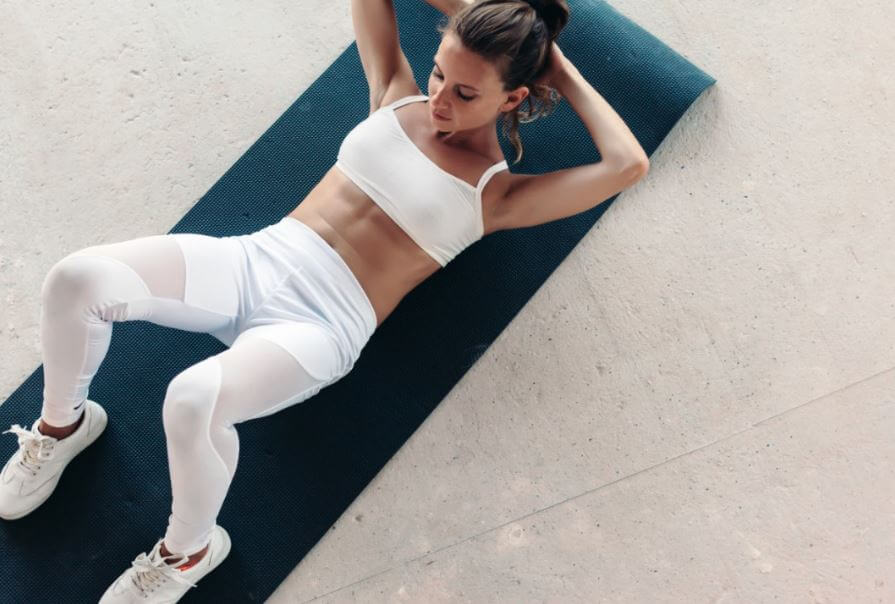Hypopressive Exercises: what are they and what do they do?

Have you ever heard about hypopressive exercises before? In our post today, we’ll fill you in on what they are, what they do for your body and how you can do them.
What are hypopressive exercises?
The hypopressive method covers a variety of exercises that use rhythmic and sequential movements, which aim to improve posture. Hypopressive exercises follow certain positions and standards.
Hypopressive exercises were created by Dr. Marcel Caufriez, who has an expert background in human kinetics and rehabilitation. He created them upon realizing that traditional abdominal exercises were actually harmful to the pelvic floor in postpartum care, or for other reasons such as urinary incontinence or prolapses.
Rather than reducing the abdominal girth (which they do), these exercises actually aim to improve posture and breathing. They’re not restricted to those in rehab for joint or muscle problems; anyone interested in improving their overall life quality can try the exercises.
What do hypopressive exercises do for your body?
As we mentioned before, these exercises aim to improve posture. However, they also boast other advantages as well that include:
1. Prevents hernias
Whether they’re inguinal, femoral, vaginal or abdominal, we suffer from hernias more often than we think we do. Once they’re there, hernias are quite painful and uncomfortable; preventing them is key.
2. Hypopressive exercises prevent your pelvic floor from changing
Urinary incontinence, prolapse, and diastasis are common in women after delivery or in menopause. Hypopressive exercises can help prevent or reduce these conditions.
3. Improves physical appearance
These exercises will slim your abdominal region, which means they offer clear visual benefits. Having more defined abs is great for your health; accumulated body fat in the abdominal region is linked with serious health problems such as heart attacks or dangerous cholesterol levels.

4. Reduced back pain
If your dorsal, lower back or cervical muscles are aching from sitting in front of a computer or driving, hypopressive exercises can be a big help. First off, they help correct posture. Secondly, they also reduce tension in the spine.
5. Prevents injuries
Another observation that Dr. Caufriez noted from traditional abdominal exercises was the alarming number of resulting injuries. While some of them were caused by poor execution, the act of forcing one’s back to move in an unnatural way was also another cause as well.
6. Improving physical performance
Another benefit of hypopressive exercises is closely related to athletic performance. For example, people who add hypopressive exercises into their routines feel stronger and enjoy a higher respiratory capacity.
This means that they’re great for people who practice fast, intense sports or ones that require endurance such as sprinters or marathon runners.
How can do you do hypopressive exercises?
Now that you’re familiar with the main benefits, let’s put them into practice. You’ll need comfortable clothes, space (a room or backyard), and an exercise mat.
1. Kneeling
This is a basic hypopressive exercise. In this exercise, participants suck in their stomach to relieve any back tension.
To get started, first kneel on the ground and line up your hips. Place your hands on the mat and bring your body forward. Keep your weight distributed on your feet, knees, hands, and forehead.
Breathe slowly as you suck in your stomach as much as you can. Hold for a few seconds. Slowly exhale to inflate your stomach again. Repeat 5 times.
2. Sitting
Here’s another hypopressive exercise that you can’t leave out. It might be tricky at first, but give it a try. Sit down with your back arched, stomach in, and your knees bent and facing outwards (similar to the Lotus position). Once you’re in place, set your hands on your glutes.
Breathe in for 2 seconds, and breathe out for 4. Repeat 3 times and in the last set, open your rib cage as you exhale. Repeat 3 more times.

3. Standing
For our last exercise, stand with your arms on your hips. Slightly bend your knees and pull your elbows outwards. Breathe, while sucking in your stomach and arching your back and pushing your shoulders forward. Repeat 3 times.
Lastly, ask a professional to help you with hypopressive exercises. The right guidance will help you master the techniques and get the most out of this wonderful workout.
Have you ever heard about hypopressive exercises before? In our post today, we’ll fill you in on what they are, what they do for your body and how you can do them.
What are hypopressive exercises?
The hypopressive method covers a variety of exercises that use rhythmic and sequential movements, which aim to improve posture. Hypopressive exercises follow certain positions and standards.
Hypopressive exercises were created by Dr. Marcel Caufriez, who has an expert background in human kinetics and rehabilitation. He created them upon realizing that traditional abdominal exercises were actually harmful to the pelvic floor in postpartum care, or for other reasons such as urinary incontinence or prolapses.
Rather than reducing the abdominal girth (which they do), these exercises actually aim to improve posture and breathing. They’re not restricted to those in rehab for joint or muscle problems; anyone interested in improving their overall life quality can try the exercises.
What do hypopressive exercises do for your body?
As we mentioned before, these exercises aim to improve posture. However, they also boast other advantages as well that include:
1. Prevents hernias
Whether they’re inguinal, femoral, vaginal or abdominal, we suffer from hernias more often than we think we do. Once they’re there, hernias are quite painful and uncomfortable; preventing them is key.
2. Hypopressive exercises prevent your pelvic floor from changing
Urinary incontinence, prolapse, and diastasis are common in women after delivery or in menopause. Hypopressive exercises can help prevent or reduce these conditions.
3. Improves physical appearance
These exercises will slim your abdominal region, which means they offer clear visual benefits. Having more defined abs is great for your health; accumulated body fat in the abdominal region is linked with serious health problems such as heart attacks or dangerous cholesterol levels.

4. Reduced back pain
If your dorsal, lower back or cervical muscles are aching from sitting in front of a computer or driving, hypopressive exercises can be a big help. First off, they help correct posture. Secondly, they also reduce tension in the spine.
5. Prevents injuries
Another observation that Dr. Caufriez noted from traditional abdominal exercises was the alarming number of resulting injuries. While some of them were caused by poor execution, the act of forcing one’s back to move in an unnatural way was also another cause as well.
6. Improving physical performance
Another benefit of hypopressive exercises is closely related to athletic performance. For example, people who add hypopressive exercises into their routines feel stronger and enjoy a higher respiratory capacity.
This means that they’re great for people who practice fast, intense sports or ones that require endurance such as sprinters or marathon runners.
How can do you do hypopressive exercises?
Now that you’re familiar with the main benefits, let’s put them into practice. You’ll need comfortable clothes, space (a room or backyard), and an exercise mat.
1. Kneeling
This is a basic hypopressive exercise. In this exercise, participants suck in their stomach to relieve any back tension.
To get started, first kneel on the ground and line up your hips. Place your hands on the mat and bring your body forward. Keep your weight distributed on your feet, knees, hands, and forehead.
Breathe slowly as you suck in your stomach as much as you can. Hold for a few seconds. Slowly exhale to inflate your stomach again. Repeat 5 times.
2. Sitting
Here’s another hypopressive exercise that you can’t leave out. It might be tricky at first, but give it a try. Sit down with your back arched, stomach in, and your knees bent and facing outwards (similar to the Lotus position). Once you’re in place, set your hands on your glutes.
Breathe in for 2 seconds, and breathe out for 4. Repeat 3 times and in the last set, open your rib cage as you exhale. Repeat 3 more times.

3. Standing
For our last exercise, stand with your arms on your hips. Slightly bend your knees and pull your elbows outwards. Breathe, while sucking in your stomach and arching your back and pushing your shoulders forward. Repeat 3 times.
Lastly, ask a professional to help you with hypopressive exercises. The right guidance will help you master the techniques and get the most out of this wonderful workout.
All cited sources were thoroughly reviewed by our team to ensure their quality, reliability, currency, and validity. The bibliography of this article was considered reliable and of academic or scientific accuracy.
- Rial, T., & Pinsach, P. (2012). Principios técnicos de los ejercicios hipopresivos del Dr. Caufriez. Educación Física y Deporte.
This text is provided for informational purposes only and does not replace consultation with a professional. If in doubt, consult your specialist.








